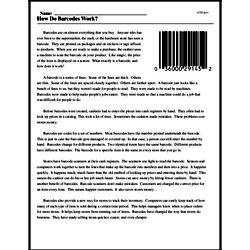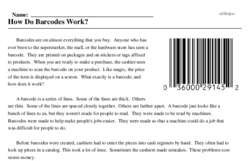How Do Barcodes Work?
Barcodes are on almost everything that you buy. Anyone who has ever been to the supermarket, the mall, or the hardware store has seen a barcode. They are printed on packages and on stickers or tags affixed to products. When you are ready to make a purchase, the cashier uses a machine to scan the barcode on your product. Like magic, the price of the item is displayed on a screen. What exactly is a barcode, and how does it work?
A barcode is a series of lines. Some of the lines are thick. Others are thin. Some of the lines are spaced closely together. Others are farther apart. A barcode just looks like a bunch of lines to us, but they weren't made for people to read. They were made to be read by machines. Barcodes were made to help make people's jobs easier. They were made so that a machine could do a job that was difficult for people to do.
Before barcodes were created, cashiers had to enter the prices into cash registers by hand. They often had to look up prices in a catalog. This took a lot of time. Sometimes the cashiers made mistakes. These problems cost stores money.




